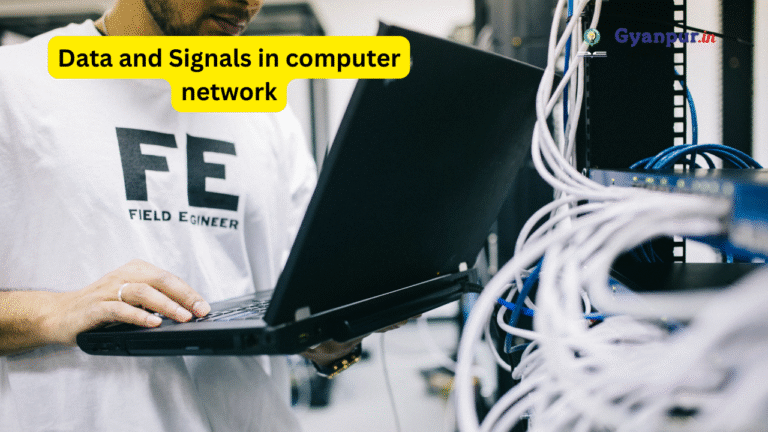Network and Transport layer | B.Tech 2nd Year Exam
The Network and Transport layer is responsible for the end-to-end delivery of individual packets from the source host to the destination host across one or more networks. It handles the logical addressing and routing of data.
The Transport Layer provides reliable and/or unreliable end-to-end data transfer between applications running on different hosts. It shields the application layer from the complexities of the underlying network.
MULTIPLEXING:
Multiplexing is a technique used in telecommunications and computer networks to combine multiple signals or data streams into a single channel for transmission over a shared communication medium. At the receiving end, a corresponding demultiplexing process separates the combined signals back into their original individual streams. (Network and Transport layer)
Frequency-Division Multiplexing (FDM):
Definition:
FDM is a technique where multiple signals are transmitted simultaneously, each using a separate frequency band within the available bandwidth of a communication channel.
Working:
- The total available bandwidth is divided into non-overlapping frequency bands.
- Each user’s signal is modulated onto a different carrier frequency.
- Guard bandsare used between frequencies to avoid interference.
Applications:
- Radio Broadcasting (FM/AM)
- Cable TV (Network and Transport layer)
- Telephone systems (old analog systems)
Advantages:
- Simultaneous transmission of multiple signals.
- Simple technique for analog signals.
Disadvantages:
- Requires large bandwidth.
- Crosstalk due to imperfect filtering.
Time-Division Multiplexing (TDM):
Definition:
TDM is a technique where multiple signals share the same communication channel, but each signal is transmitted in different time slots in a cyclic order. (Network and Transport layer)
Working:
- The channel is divided into fixed or dynamic time slots.
- Each signal gets the entire channel bandwidth but only for its time slot.
- After finishing its time slot, the next signal gets its chance, and the cycle repeats.
Types of TDM:
- Synchronous TDM: Fixed time slots for each user.
- Statistical TDM: Time slots are dynamically allocated based on demand.
Applications:
- Digital Telephony (PCM)
- Computer Networks
- Satellite Communication
Advantages:
- Efficient for digital data.
- No need for large bandwidth like FDM.
Disadvantages:
- Wastage of bandwidth in Synchronous TDM if users are idle.
- Synchronization is required. (Network and Transport layer)
Wavelength-Division Multiplexing (WDM):

Definition:
WDM is a multiplexing technique used in optical fiber communication, where multiple data streams are transmitted simultaneously using different wavelengths of light (different colors).
Working:
- Each data channel is assigned a unique wavelength.
- All light signals of different wavelengths are combined using amultiplexer.
- At the receiving end, a demultiplexer separates the signals. (Network and Transport layer)
Types of WDM:
- Coarse WDM (CWDM): Larger wavelength spacing.
- Dense WDM (DWDM): Closer wavelength spacing, more channels.
Applications:
- High-speed Internet through fiber optics.
- Long-distance telecommunication networks.
Advantages:
- Very high bandwidth capacity.
- Efficient use of existing fiber infrastructure.
Disadvantages:
- Expensive equipment. (Network and Transport layer)
- Requires precise control of wavelengths.
Comparison Table:
| Feature | FDM | TDM | WDM |
|---|---|---|---|
| Medium | Copper cables, Wireless | Copper cables, Digital lines | Optical Fiber |
| Signal Type | Analog | Digital | Optical |
| Division Basis | Frequency Bands | Time Slots | Light Wavelengths |
| Simultaneity | Signals sent at same time | Signals sent in sequence (time) | Signals sent at same time |
| Guard Bands / Synchronization | Requires guard bands | Requires synchronization | Requires precise wavelength control |
| Applications | Radio, TV, Cable TV | Telephony, Data transmission | Fiber optic communication |
| Bandwidth Usage | Large | Efficient for digital | Extremely high capacity |
Function of Data Link Layer
The Data Link Layer is responsible for node-to-node delivery of frames across a physical link in a network. (Network and Transport layer)
Main Functions:
- Framing:
- Divides the data from the Network Layer into manageable frames for transmission.
- Physical Addressing:
- Adds the MAC (Media Access Control) address of sender and receiver to the frame.
- Error Detection and Correction:
- Detects and sometimes corrects errors that occur in the Physical Layer using methods like CRC (Cyclic Redundancy Check).
- Flow Control:
- Controls the data flow between sender and receiver to prevent the fast sender from overwhelming the slow receiver.
- Access Control (MAC):
- Determines which device has control over the communication channel at a given time, especially in shared medium networks.
- Acknowledgement and Retransmission:
- Ensures reliable delivery by sending acknowledgments and retransmitting lost or corrupted frames (in protocols like HDLC). (Network and Transport layer)
Also Read:- CPU Scheduling & Concurrency in Operating Systems | Best Pdf for 2025 – 2026 Exam






